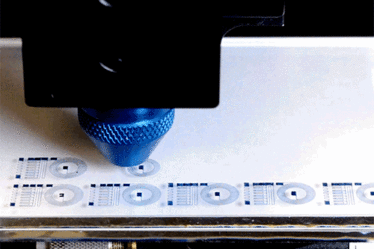Apr 11, 2019 | By Thomas
One of the ways of making bioengineered tissues is to embed living cells within 3D printed structures. But one challenge has been organizing the cells in 3D bioprinted gels, so that the engineered tissue more closely mimics natural tissues. Researchers at North Carolina State University have developed a way to improve the characteristics of artificial tissues by using ultrasound to align living cells during the biofabrication process.

A 3D bioprinted human knee meniscus. Photo credit: Rohan Shirwaiker, NC State University
“We’ve reached the point where we are able to create medical products, such as knee implants, by printing living cells,” says Rohan Shirwaiker, corresponding author of a paper on the work and an associate professor in NC State’s Edward P. Fitts Department of Industrial & Systems Engineering.
“We’ve now developed a technique, called ultrasound-assisted biofabrication (UAB), which allows us to align cells in a three-dimensional matrix during the bioprinting process. This allows us to create a knee meniscus, for example, that is more similar to a patient’s original meniscus. To date, we’ve been able to align cells for a range of engineered musculoskeletal tissues.”
Researchers developed their UAB method using a BioAssemblyBot direct ink writing (DIW) 3D bioprinter. To align the cells, they built an ultrasound chamber that allows ultrasonic waves to travel across the area where a bioprinter prints living cells. These ultrasonic waves flow from one wall toward the opposite, bouncing back and creating a “standing ultrasound wave.” The soundwaves effectively align the cells into rows, and as a structure is printed and cells positioned within, thye can be arranged to make specific patterns and orientations.
“We can control the alignment characteristics of the cells by controlling the parameters of the ultrasound, such as frequency and amplitude,” Shirwaiker says.
To demonstrate the viability of the UAB technique, the researchers successfully created a knee meniscus, with the cells aligned in a semilunar arc – just as they are in a natural meniscus.
“We were able to control the alignment of the cells as they were printed, layer by layer, throughout the tissue,” Shirwaiker says. “We’ve also shown the ability to align cells in ways that are particularly important for other orthopedic soft tissues, such as ligaments and tendons.”
One of the advantages of the UAB technique is that it is relatively inexpensive. “There’s a one-time cost for setting up the ultrasound equipment – which can use off-the-shelf technology,” Shirwaiker says. “After that, the operating costs for the ultrasound components are negligible. And the UAB technique can be used in conjunction with most existing bioprinting technologies.”
The team now has a patent pending for the UAB technique and is looking for industry partners to take it into commercial use.
The paper, “Ultrasound-assisted biofabrication and bioprinting of preferentially aligned three-dimensional cellular constructs,” is published in the journal Biofabrication.
Posted in 3D Printing Application
Maybe you also like:
Jin wrote at 4/12/2019 2:32:54 PM:
My god this is honestly so amazing it’s laughable!
HAHA damn, it might just be me but I’m quite astonished at the advancements that humanity has pursued as now it’s hypothetically possible for a person to lose their lower limbs from the waist down and be able to recreate them with the help of a new bioprinted human knee meniscus, new bones printed from osteochondral tissue, new nerve growth from stem cells and scaffolding, etc.
Truly some remarkable work is being done keep up the fantastic work!

